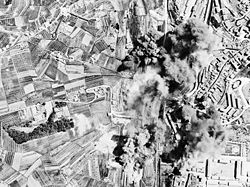- Operation Strangle
-
Operation Strangle was a series of air operations during the Italian Campaign of World War II by the United States Fifteenth and Twelfth Air Forces to interdict German supply routes in Italy north of Rome from March 24, 1943, until the fall of Rome in spring 1944. Its aim was to prevent essential supplies from reaching German forces in central Italy and compel a German withdrawal. The strategic goal of the air assault was to eliminate or greatly reduce the need for a ground assault on the region. Although the initial goal of forcing the enemy to withdraw was not achieved, the air interdiction of Operation Strangle played a major role in the success of the subsequent ground assault Operation Diadem.[1]
Two principal interdiction lines were maintained across the narrow boot of Italy. This meant that no through trains were able to run from the Po Valley to the front line, and that south of Florence substantially all supplies had to be moved by truck.[2] The operation employed medium bombers and fighter bombers over a 150-square-mile (390 km2) area from Rome to Pisa and from Pescara to Rimini.[3]
Operation Strangle was also the name of the unsuccessful rail interdiction operation of the United Nations Command air forces in 1951-52 during the Korean War.
Contents
Diadem phase
Operation Strangle achieved air superiority before the Diadem phase commenced. During Diadem, commanders continued interdicting supply lines but also conducted close air support to maintain air superiority. Some changes in target selection proved to have far-reaching effects on later military doctrine: a partial switch from rail to road targets, coupled with a concentration on the region closest to enemy lines, aimed to cripple the enemy by denying reliable transportation and reducing access to local supplies.[4]
These efforts impaired but did not critically deplete German access to fuel and ammunition. The Germans used alternate routes and quickly repaired damaged points, especially at night and in bad weather, when the Americans could not bomb. German supply needs were low during the Operation Strangle, so in some respects they were able to maintain and even increase supplies.[5]
The major benefit to the Allies of Operation Strangle was unintended: it reduced German troop mobility. The Germans had no reserve forces behind front lines and relied upon tactical mobility, so the inability to transfer forces quickly to weakly held points crippled their battle readiness. Three weeks after the ground campaign began, the Germans were in full retreat.[6]
Analysis
According to a 1972 Rand Corporation case study of the mission, Operation Strangle was an important milestone in the development of United States military interdiction doctrine. The report's conclusion was that the overriding objective of supply denial was unattainable. Interdiction was a relatively new military strategy at the time, and American commanders lacked adequate understanding of German supply methods. Although supply denial was not the sole mission of the operation, it remained the primary goal even after it had clearly failed. The effect on troop movement was incidental. According to the Rand report:
Interdiction was a relatively novel mission and there was a good deal of improvisation as the campaign went along. Fortunately for its success, the tactical air commanders and their pilots seem to have improvised in the right direction.[7]See also
References
- ^ "Operation 'Strangle', (Italy, Spring 1944): A Case Study of Tactical Air Interdiction, p. 5., by F.M. Sallagar, Rand Corporation.[1] Accessed 5 July 2008.
- ^ United States Air Force official website.[2] Accessed 5 July 2008.
- ^ Time magazine, Monday, May 8, 1944.[3] Accessed 5 July 2008.
- ^ "Operation 'Strangle', (Italy, Spring 1944): A Case Study of Tactical Air Interdiction, pp. 5-6.[4] Accessed 5 July 2008.
- ^ "Operation 'Strangle', (Italy, Spring 1944): A Case Study of Tactical Air Interdiction, pp. 9.[5] Accessed 5 July 2008.
- ^ "Operation 'Strangle', (Italy, Spring 1944): A Case Study of Tactical Air Interdiction, p. 9.[6] Accessed 5 July 2008.
- ^ "Operation 'Strangle', (Italy, Spring 1944): A Case Study of Tactical Air Interdiction, pp. 5, 10-11.[7] Accessed 5 July 2008.
Categories:- Italian Campaign
- Aerial operations and battles of World War II
- Battles involving the United States
- Military operations of World War II involving Germany
Wikimedia Foundation. 2010.

